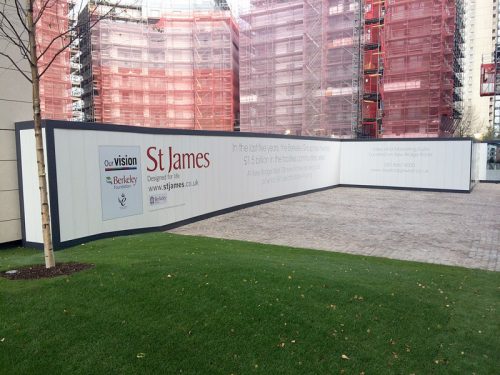Here at Plasloc, we have provided our patented Plasloc hoarding solutions for internal and external construction works across a wide range of sectors for many years. They are subject to a range of construction hoarding guidelines, which we’ve compiled into this handy blog.
Is site hoarding a legal requirement?
To comply with the Health and Safety at Work Act 1974, all employers and the self-employed must take reasonable steps to keep the general public safe. The implication of this is that construction sites need a protective boundary, with site hoarding being the most fitting solution.
Construction (Design & Management Regulations) 2015
The Construction (Design & Management) Regulations also explicitly state that unauthorised access must be prevented from construction sites. Therefore, is it necessary for suitable hoarding to be put in place.
Safety guidelines for construction hoardings
In order to protect the public and prevent access to a construction site, there are various requirements for construction site hoarding, which can be summarised into the following:
- It should be high enough so that it cannot be scaled
- It should be sturdy enough that it cannot be knocked down
- The hoarding should obscure the site from view to deter theft and the temptation for people to enter
- Access to the site should be controlled via secure gates, access points, etc.
A more in-depth summary is available in our related blog: Are there any construction site hoarding requirements?
Who is responsible for construction hoarding?

The principal contractor has responsibility for construction site hoarding. However, whether they wish to design the hoarding themselves or employ a subcontractor to do it for them is their choice.
Temporary Works Co-ordinators (TWC)
Hoardings are classed as temporary works, which means it is common practice for contractors to employ a Temporary Works Coordinator (TWC) to oversee the construction and removal of any hoarding. TWC’s are also responsible for scaffolding and any other temporary structures that are used on site.
BS5975:2019
BS5975:2019 is the British Standard for the code of practice for temporary works procedures, and this recommends employing a temporary works co-ordinator as this can help avoid potential safety hazards.
When do construction hoardings need to be in place?
Before any construction work starts. In most cases, this is essential for complying with the Health and Safety at Work Act 1974, Construction (Design & Management) Regulations 2015 and other relevant guidance.
Planning and provision of site perimeters
Before any site hoarding is fitted, the principal contractor is required to take adequate planning and provision:
- Take a risk assessment, identifying any hazards and assessing their risk
- Define the perimeter of the site that needs protecting
- Identify a suitable solution for protecting the site (hoarding, fencing, etc.)
The contractor, or Temporary Works Co-ordinator (if employed), are then responsible for erecting any site boundary and ensuring that it is equipped with sufficient warning and information signage.
Here at Plasloc, our hoarding solutions are available with Diabond, foamex and Vinyl graphics, ensuring any necessary signage can be incorporated into their design.
Design and check certificates
After creating a plan for the hoarding’s design, a relevant design check certificate will need to be obtained by a qualified individual. This excludes the individual who designed the hoarding, but they can be granted by a Temporary Works Co-ordinator.
The person granting the design check certificate needs to ensure the proposed hoarding is compliant with a recognised code like BS 5975:2008 and that it is strong and suitable enough in the context of that particular construction site.
Should site hoardings be inspected regularly?
Once erected, the protective boundary must be regularly inspected and if any maintenance is required, it must be carried out. As a project progresses and the use of the construction site changes, the hoarding should also be altered accordingly.
How long should hoardings last?
 Hoarding needs to last for as long as construction is taking place on a particular site. However, whilst the length of time will depend on the individual project circumstances, the standard acceptable lifespan of site hoarding is 10 years.
Hoarding needs to last for as long as construction is taking place on a particular site. However, whilst the length of time will depend on the individual project circumstances, the standard acceptable lifespan of site hoarding is 10 years.
When hiring the patented Plasloc product for use on a construction project, it is installed to our structural engineer’s site-specific site calculation to meet all your temporary works requirements. It’s also an interlocking system that requires no ground penetration, so it can easily be installed at the start of the project and removed at the end of it.
Agreeing the lifespan of site hoardings
The lifespan of any hoarding should be discussed by the client, principal contractor, temporary works co-ordinator and any other relevant parties, who will then need to agree a reasonable lifespan. It is common for hoardings to move location and have their size and shape altered, and this will also need to be accounting for.
What is construction site hoarding usually made from?
Steel and timber are two popular materials used for hoarding, although, there have been strength issues with timber hoardings in the past.
Here at Plasloc, we our patented hoarding solutions are built from 100% recycled post-consumer or post-industrial PVC-U. Ultra-durable and eco-friendly, it is suitable for all types of construction works.
Do you require a high-performance hoarding solution for a construction site? Get in touch with Plasloc today. We are available to call on 01626 356 995 or you can contact us online.
Related to this post:
What is construction hoarding?
Get in touch
Get a quote today
Do you require the best hoarding solution for your hoarding construction project? We’re here to help support you from start to finish, whether it is large or small, we will find the best hoarding construction solution for you.
Get a quote


 Internal Hoarding
Internal Hoarding External Hoarding
External Hoarding Demo Wall System
Demo Wall System Plasklad
Plasklad Internal Hoarding
Internal Hoarding External Hoarding
External Hoarding Demo Wall System
Demo Wall System Plasklad
Plasklad